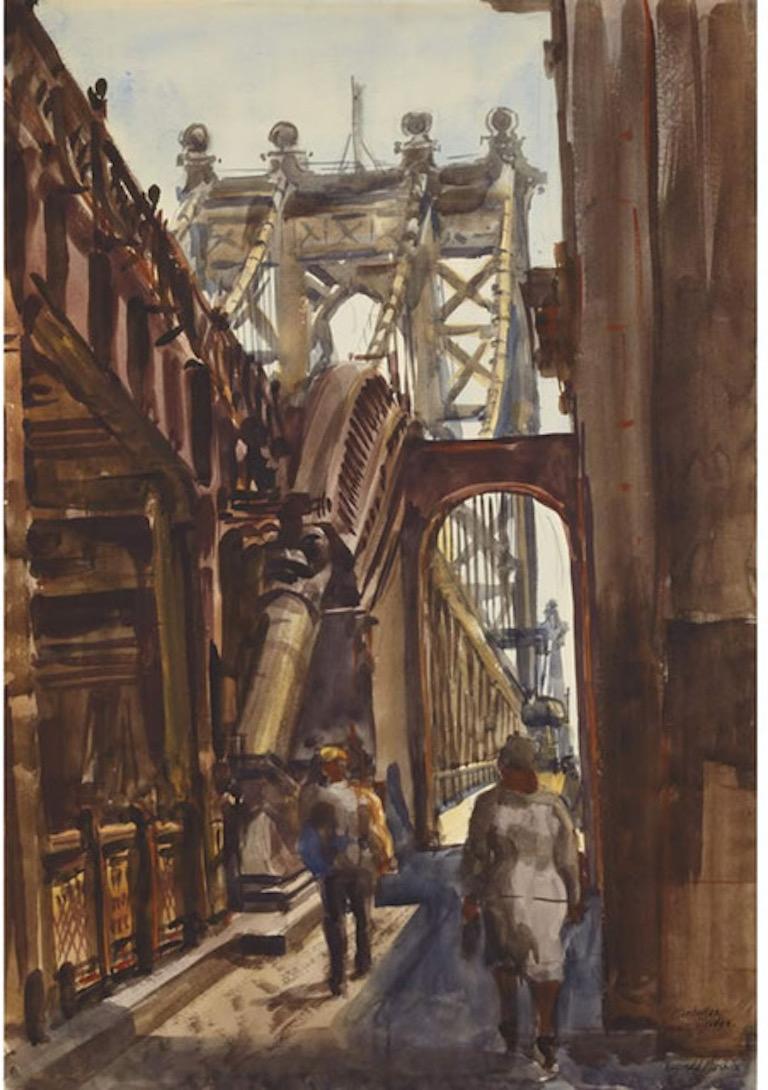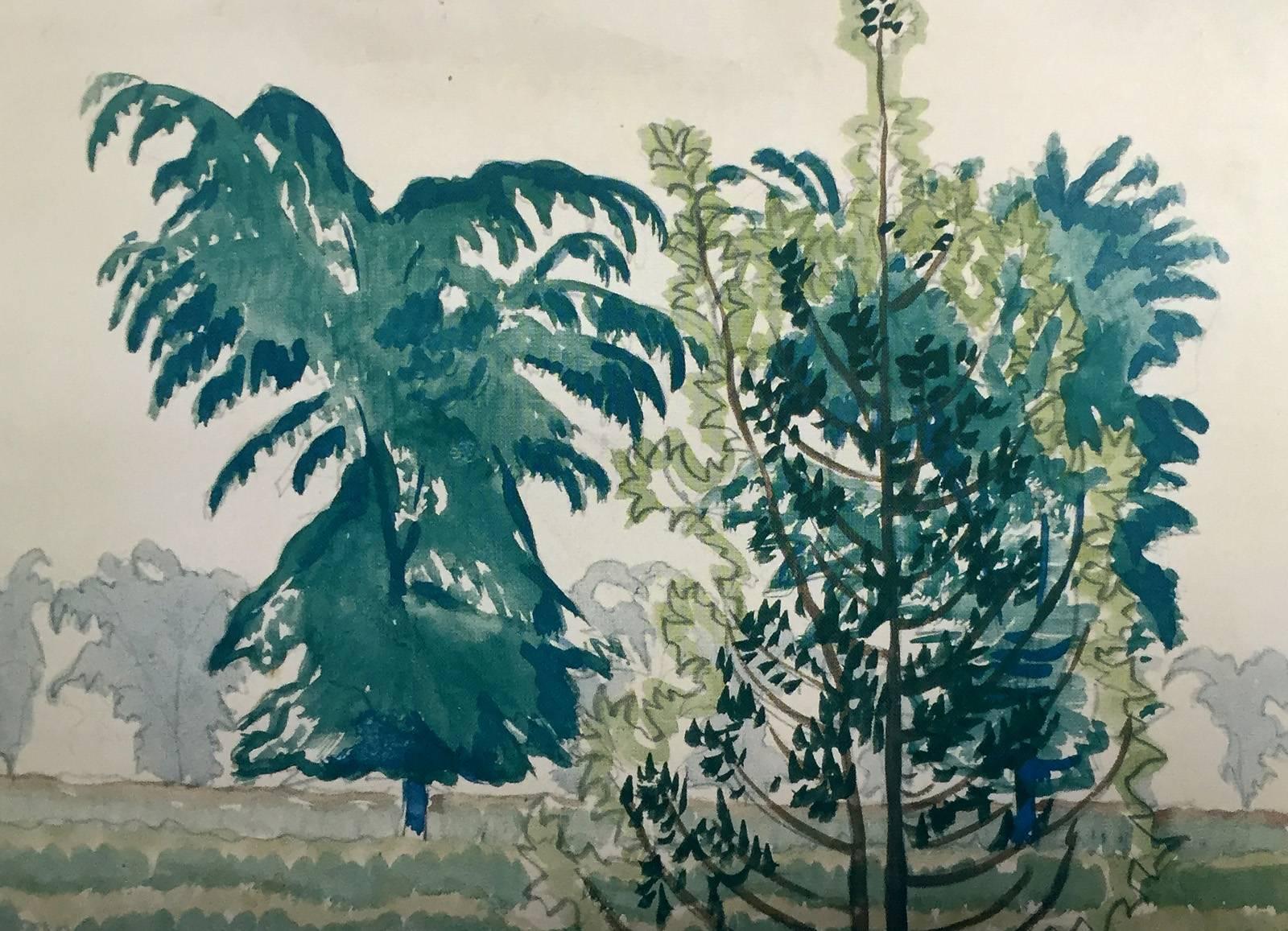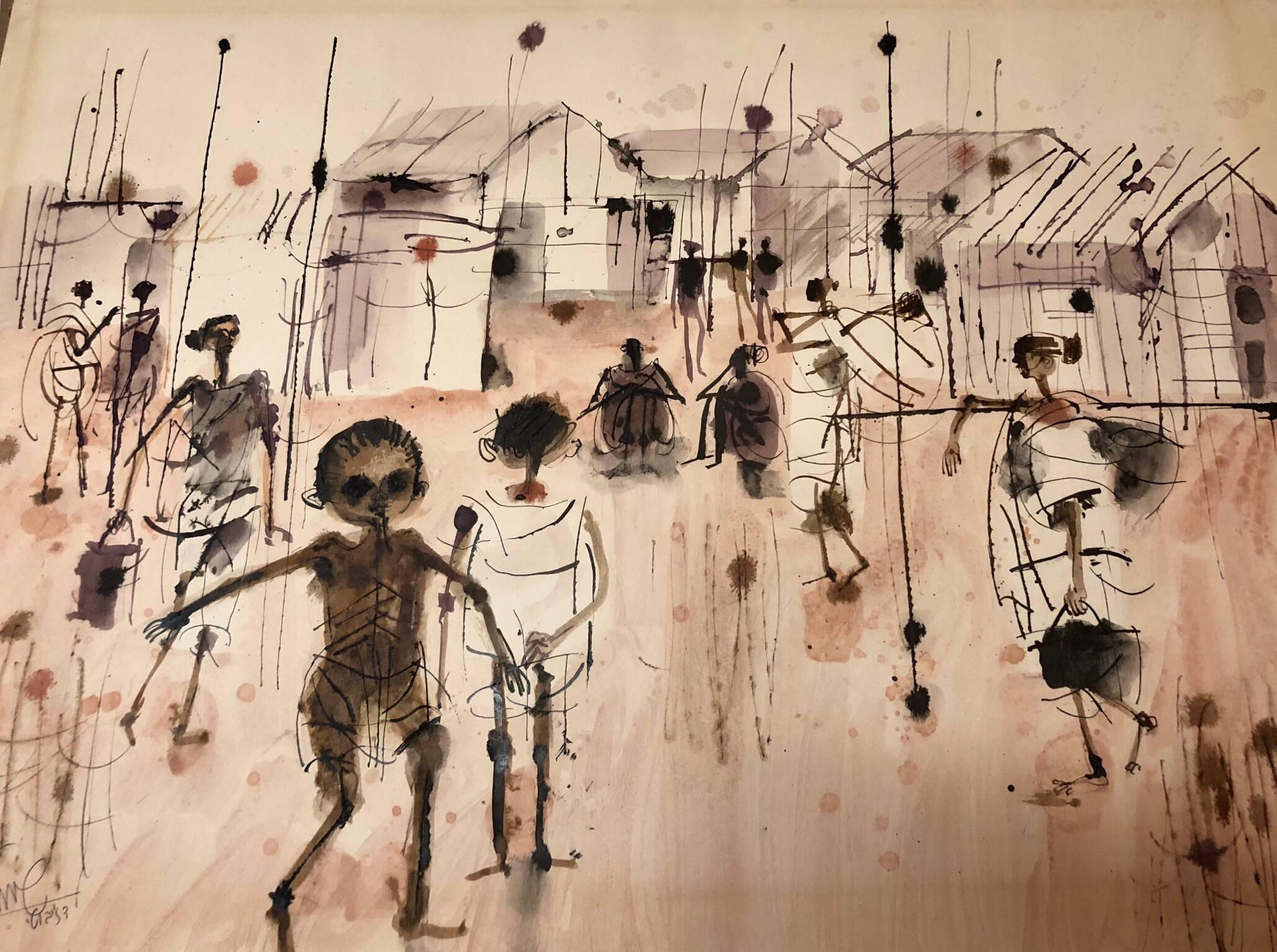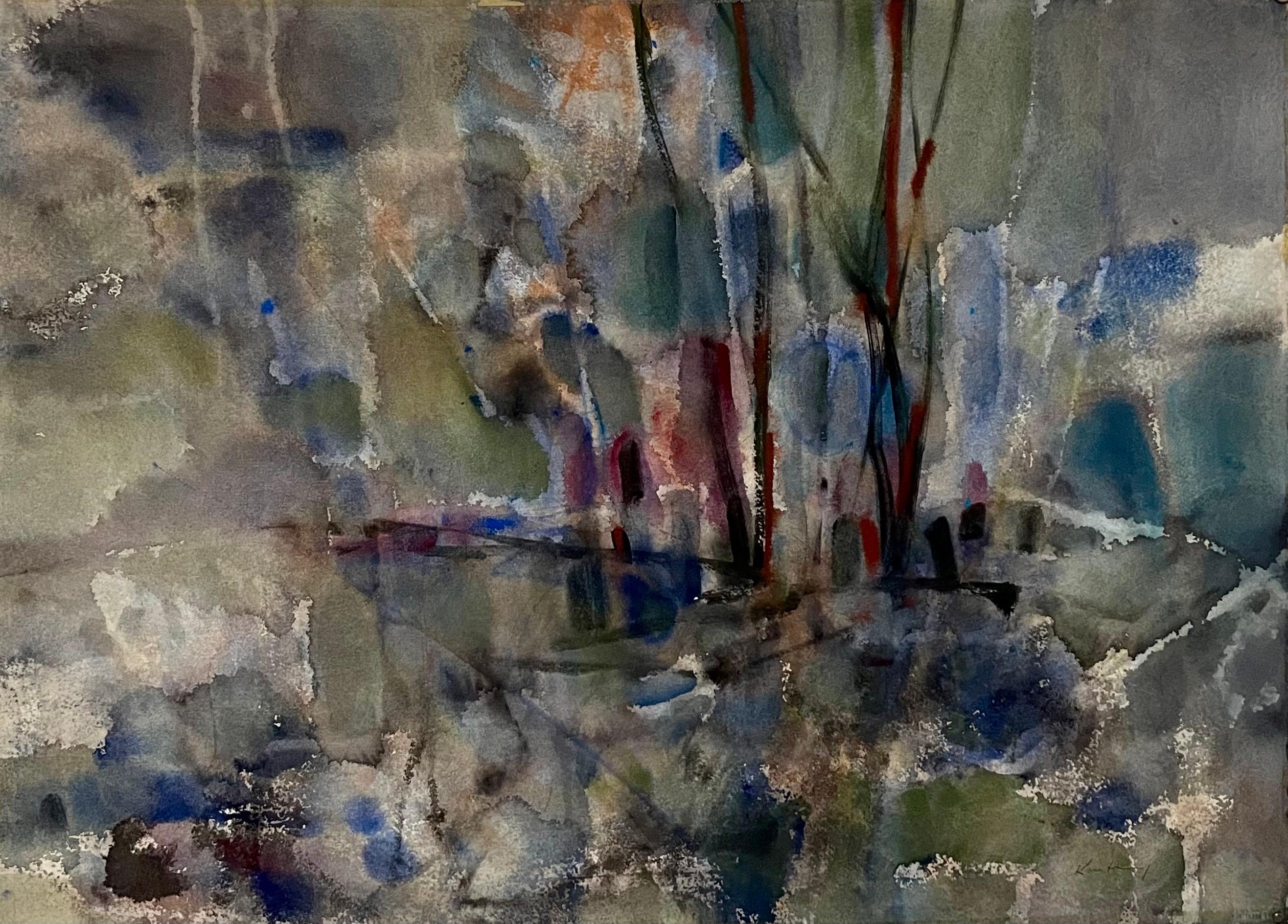Charles E. BurchfieldBefore the Storm1916
1916
About the Item
- Creator:Charles E. Burchfield (1893-1967, American)
- Creation Year:1916
- Dimensions:Height: 14 in (35.56 cm)Width: 20 in (50.8 cm)
- Medium:
- Movement & Style:
- Period:
- Condition:
- Gallery Location:Buffalo, NY
- Reference Number:1stDibs: LU13922199013
Charles E. Burchfield
Born in Ashtabula Harbor, Ohio, Charles Burchfield became known as a town-landscape painter of middle-western America, and his paintings, drawings and prints have had much influence on succeeding generations of artists. He has also been described as a social critic, naturalist, and transcendental visionary whose sensitivities infuse his artwork. Of his impact on American art, Matthew Baigell wrote: "Few American artists have ever responded with such passion to the landscape or have made it such a compelling repository as well as mirror of their intimate feelings."
In addition to his painting, Burchfield was a teacher at the Art Institute of Buffalo from 1949 to 1952 and at the University of Buffalo from 1950 to 1952.
Burchfield's career can be divided into three phases. The first is landscapes based on childhood memories and fantasies and ended about 1918; the second, from 1918 to 1943, is Social Realism, including “grimy streets and rundown buildings of the eastern Ohio area,” and the third phase is a return to subject matter of his childhood and the “investing them with a kind of ecstatic poetry.” (Biagell 54)
Throughout Burchfield's career, watercolor was his preferred medium. Knowledge of Oriental art influenced him to use simple forms.
Burchfield spent his youth in Salem, Ohio, where he developed a keen interest in art and nature and was intensely aware of woodland sounds and noises. In 1912, he decided to become a painter and enrolled in the Cleveland School of Art, where his most influential teacher was Henry Keller. Another major Ohio influence on his painting was William Sommer, leader of the modernist movement in the Cleveland area. He introduced Burchfield to experimental watercolor techniques and color theory, and Burchfield began attending sessions of the Kokoon Club, organized by Sommer and William Zorach to promote avant-garde art. In 1917, he developed a shorthand of abstractions of various shapes and moods, and he also began painting small houses that appeared to be haunted.
Burchfield served in World War I from 1918 to 1919, and served as sergeant in the Camouflage Corps, camouflaging artillery pieces. In 1921, he moved to Buffalo, New York, where until 1929, he worked as a wallpaper designer for the M.H. Birge and Sons Wallpaper Company. From that time, living the remainder of his life in Buffalo, he devoted himself full time to fine-art painting that ranged from rather sentimental depictions to abstraction in the 1960s.
In the 1920s, Burchfield moved away from what he perceived as an overactive imagination and did studies of architecture of Midwestern streets. This subject matter of the realities of the man-made world was influenced by his reading of Winesburg, Ohio: A Group of Tales of Ohio Small-Town Life by Sherwood Anderson, and playing off those themes he reflected a debunking of the heartland sentimentality by so-called sophisticated, more worldly critics. Then in 1943, he returned to his earlier style which he explained was a "necessary diversion" from the aftermath of World War II.
Once more Burchfield began to explore the landscape of his youth, and, using a less realistic style, became almost mystical in his expressions of nature including seasonal changes, and forest sounds, which he depicted with quivering brushstrokes. "His last paintings are filled with chimerical creatures — butterflies and dragonflies from another world." (Baigell 55)
The largest single collection of Burchfield’s work is at the Burchfield-Penney Art Center in Buffalo, New York, and includes his watercolors, prints, oil paintings and preliminary sketches for both paintings and wallpaper designs. In 1997, a major retrospective of his work was held at the National Museum of American Art in Washington, D.C. and was organized by the Columbus Museum of Art.
Find original Charles Burchfield paintings and prints on 1stDibs.
(Biography provided by Gallery of the Masters)
- ShippingRetrieving quote...Ships From: Buffalo, NY
- Return PolicyA return for this item may be initiated within 10 days of delivery.
- Untitled (Trees)By Charles E. BurchfieldLocated in Buffalo, NYAn original watercolor on paper by American modernist Charles E. Burchfield, created in 1916. This work comes in an archival frame presentation and has been authenticated by the Bur...Category
1910s American Modern Landscape Drawings and Watercolors
MaterialsWatercolor, Paper
- Sun over Mont BlancBy Wes OlmstedLocated in Buffalo, NYAn original watercolor painting by Westley "Wes" Olmsted. This work is currently featured in the exhibition Man of Extremes at Benjaman Gallery in Buffalo, NY. Westley G. Olmsted ...Category
1980s Modern Landscape Drawings and Watercolors
MaterialsWatercolor, Paper
- Nude Picnic Virgin IslandsBy Robert Noel BlairLocated in Buffalo, NYRobert Noel Blair (American, 1912-2003) was an American artist, painter, sculptor, printmaker and teacher. He is best known for his rural life & desert landscapes and World War II sc...Category
1960s American Modern Nude Drawings and Watercolors
MaterialsWatercolor, Archival Paper
- Rainstorm SunsetBy Robert Noel BlairLocated in Buffalo, NYYou are viewing a modernist American watercolor painting by Robert Noel Blair. Robert Noel Blair (American, 1912-2003) was an American artist, painter, sculptor, printmaker and te...Category
American Modern Landscape Drawings and Watercolors
MaterialsPaper, Watercolor
- California Impressionist Landscape Painting Framed 19th Century Rare PurpleLocated in Buffalo, NYAn original American impressionist figurative watercolor of a California coastline with trees.Category
Early 1900s American Modern Landscape Drawings and Watercolors
MaterialsPaper, Watercolor
- French Cubist Landscape Gouache Painting Framed Original Gallery LabelLocated in Buffalo, NYGouache of a French cityscape titled "Street in Gordes France" by Sylvia Davis. This piece was originally part of the lending and sales gallery of the Memorial Art Gallery of the Uni...Category
1960s Modern Landscape Drawings and Watercolors
MaterialsPaper, Watercolor, Gouache
- "Manhattan Bridge" NYC American Scene Modernism Watercolor WPA Urban RealismBy Reginald MarshLocated in New York, NYReginald Marsh "Manhattan Bridge" NYC American Scene Modernism Watercolor WPA Urban Realism, 20 x 14 inches. Watercolor and pencil on paper, 1938. Signed...Category
1930s American Modern Landscape Drawings and Watercolors
MaterialsPaper, Watercolor, Pencil
- "Winter Wonderland (Snowman, Pine Tree, Rabbit), " signed by Sylvia SpicuzzaBy Sylvia SpicuzzaLocated in Milwaukee, WI"Winter Wonderland (Snowman, Pine Tree, Rabbit)" is a gouache and collage on paper bag signed by Sylvia Spicuzza. A winter scene showing a happy snowman that was created with arms up in the air and a top hat upon his head. In the foreground sits a bunny looking at the snow man...Category
1950s American Modern Landscape Drawings and Watercolors
MaterialsGouache, Paper
- Djibouti, African Landscape Original Israeli Watercolor Cityscape PaintingLocated in Surfside, FLSubject: Cityscape, signed in Hebrew Medium: Watercolor Surface: Paper Shmuel Katz (Hebrew: שמואל כ"ץ) (August 18, 1926 – March 26, 2010) was an Israeli artist, illustrator, and car...Category
20th Century Modern Landscape Drawings and Watercolors
MaterialsPaper, Watercolor
- Modernist Abstract Expressionist Watercolor Painting Bauhaus Weimar Pawel KontnyBy Pawel KontnyLocated in Surfside, FLAbstract watercolor composition bearing the influence of the earlier color-block compositions of Paul Klee. Pawel August Kontny, (Polish-German-American artist) He was born in Laurahuette, Poland, in 1923, the son of a wealthy pastry shop owner. In 1939 he began studying architecture in Breslau where he was introduced to the European masters and to the work of some of the German Expressionists, soon afterward banned as "degenerate artists" and removed from museums throughout Germany by the Nazi regime. His studies were interrupted by World War II. Drafted into the German army, traveling in many countries as a soldier, he sketched various landscapes but in 1945, he was captured and held as a prisoner of war in Italy. After the war, he studied at the Union of Nuremberg Architects to help design buildings to replace ones destroyed in the war. He recorded his impressions of the local population and the landscapes through his watercolors and drawings. Pawel Kontny thereafter moved to Nuremberg, Germany, becoming a member of the Union of Nuremberg Architects and helping to rebuild the city's historic center. He soon decided to concentrate on his professional art career. He married Irmgard Laurer, a dancer with the Nuremberg Opera. Pavel Kontny 's career as an artist was launched with his participation in an all German exhibition, held at the Dusseldorf Museum in 1952. He held one-man shows in Germany, Switzerland and the United States. During his trip to the United States in 1960, Kontny became instantly enamored with Colorado, and decided to relocate to Cherry Hills with his wife and two children. He quickly established himself in the local art community, being affiliated for a time with Denver Art Galleries and Saks Galleries. His subject matter became the Southwest. During this time he received the Prestigious Gold Medal of the Art Academy of Rome. His extensive travel provided material for the paintings he did using his hallmark marble dust technique. he also worked equally in pastel, watercolor, charcoal and pencil-and-ink. in a style which merged abstraction and realist styles, influenced by Abstract Expressionist painting and South Western American landscapes. This one bears the influence of Sam Francis. In the early 1960s he was one of only a few European-born professional artists in the state, a select group that included Herbert Bayer (1900-1985), a member of the prewar Bauhaus in Weimar and Dessau, Germany, and Roland Detre (1903-2001), a Hungarian modernist painter. As a Denver, Colorado resident, Pavel Kontny exhibited at galleries and museums throughout the United States, Germany and Japan. There, he was inspired by frequent trips to Native American pueblos in the Southwest, as well as by the study of the Plains Indians of Montana and Wyoming. Over the years Kontny had a number of students and generously helped young artist by hosting exhibitions at his Cherry Hills home. For many years he generously donated his paintings to support charitable causes in Denver. Influences during his European years included German pastelist C.O. Muller, German Informel painter Karl Dahmen and Swiss artist, Hans Erni. In the early 1950s his painting style showed the influence of the Die Brücke (The Bridge), a group of German expressionist artists formed in Dresden in 1905 who had a major impact on the evolution of modern art in the twentieth century in Germany. By the middle of the decade his style incorporated more referential abstraction and total abstraction, resulting in part from his study of Hans Hartung, a German artist based in Paris who exhibited his gestural abstract work in Germany. The American moon landing in 1969 inspired Paul Kontny...Category
20th Century American Modern Abstract Drawings and Watercolors
MaterialsWatercolor, Archival Paper
- Modernist Abstract Expressionist Watercolor Painting Bauhaus Weimar Pawel KontnyBy Pawel KontnyLocated in Surfside, FLAbstract watercolor composition bearing the influence of the earlier color-block compositions of Paul Klee. Pawel August Kontny, (Polish-German-American artist) He was born in Laurahuette, Poland, in 1923, the son of a wealthy pastry shop owner. In 1939 he began studying architecture in Breslau where he was introduced to the European masters and to the work of some of the German Expressionists, soon afterward banned as "degenerate artists" and removed from museums throughout Germany by the Nazi regime. His studies were interrupted by World War II. Drafted into the German army, traveling in many countries as a soldier, he sketched various landscapes but in 1945, he was captured and held as a prisoner of war in Italy. After the war, he studied at the Union of Nuremberg Architects to help design buildings to replace ones destroyed in the war. He recorded his impressions of the local population and the landscapes through his watercolors and drawings. Pawel Kontny thereafter moved to Nuremberg, Germany, becoming a member of the Union of Nuremberg Architects and helping to rebuild the city's historic center. He soon decided to concentrate on his professional art career. He married Irmgard Laurer, a dancer with the Nuremberg Opera. Pavel Kontny 's career as an artist was launched with his participation in an all German exhibition, held at the Dusseldorf Museum in 1952. He held one-man shows in Germany, Switzerland and the United States. During his trip to the United States in 1960, Kontny became instantly enamored with Colorado, and decided to relocate to Cherry Hills with his wife and two children. He quickly established himself in the local art community, being affiliated for a time with Denver Art Galleries and Saks Galleries. His subject matter became the Southwest. During this time he received the Prestigious Gold Medal of the Art Academy of Rome. His extensive travel provided material for the paintings he did using his hallmark marble dust technique. he also worked equally in pastel, watercolor, charcoal and pencil-and-ink. in a style which merged abstraction and realist styles, influenced by Abstract Expressionist painting and South Western American landscapes. This one bears the influence of Sam Francis. In the early 1960s he was one of only a few European-born professional artists in the state, a select group that included Herbert Bayer (1900-1985), a member of the prewar Bauhaus in Weimar and Dessau, Germany, and Roland Detre (1903-2001), a Hungarian modernist painter. As a Denver, Colorado resident, Pavel Kontny exhibited at galleries and museums throughout the United States, Germany and Japan. There, he was inspired by frequent trips to Native American pueblos in the Southwest, as well as by the study of the Plains Indians of Montana and Wyoming. Over the years Kontny had a number of students and generously helped young artist by hosting exhibitions at his Cherry Hills home. For many years he generously donated his paintings to support charitable causes in Denver. Influences during his European years included German pastelist C.O. Muller, German Informel painter Karl Dahmen and Swiss artist, Hans Erni. In the early 1950s his painting style showed the influence of the Die Brücke (The Bridge), a group of German expressionist artists formed in Dresden in 1905 who had a major impact on the evolution of modern art in the twentieth century in Germany. By the middle of the decade his style incorporated more referential abstraction and total abstraction, resulting in part from his study of Hans Hartung, a German artist based in Paris who exhibited his gestural abstract work in Germany. The American moon landing in 1969 inspired Paul Kontny...Category
20th Century American Modern Abstract Drawings and Watercolors
MaterialsWatercolor, Archival Paper
- Modernist Abstract Expressionist Watercolor Painting Bauhaus Weimar Pawel KontnyBy Pawel KontnyLocated in Surfside, FLAbstract watercolor composition bearing the influence of the earlier color-block compositions of Paul Klee. Pawel August Kontny, (Polish-German-American artist) He was born in Laurahuette, Poland, in 1923, the son of a wealthy pastry shop owner. In 1939 he began studying architecture in Breslau where he was introduced to the European masters and to the work of some of the German Expressionists, soon afterward banned as "degenerate artists" and removed from museums throughout Germany by the Nazi regime. His studies were interrupted by World War II. Drafted into the German army, traveling in many countries as a soldier, he sketched various landscapes but in 1945, he was captured and held as a prisoner of war in Italy. After the war, he studied at the Union of Nuremberg Architects to help design buildings to replace ones destroyed in the war. He recorded his impressions of the local population and the landscapes through his watercolors and drawings. Pawel Kontny thereafter moved to Nuremberg, Germany, becoming a member of the Union of Nuremberg Architects and helping to rebuild the city's historic center. He soon decided to concentrate on his professional art career. He married Irmgard Laurer, a dancer with the Nuremberg Opera. Pavel Kontny 's career as an artist was launched with his participation in an all German exhibition, held at the Dusseldorf Museum in 1952. He held one-man shows in Germany, Switzerland and the United States. During his trip to the United States in 1960, Kontny became instantly enamored with Colorado, and decided to relocate to Cherry Hills with his wife and two children. He quickly established himself in the local art community, being affiliated for a time with Denver Art Galleries and Saks Galleries. His subject matter became the Southwest. During this time he received the Prestigious Gold Medal of the Art Academy of Rome. His extensive travel provided material for the paintings he did using his hallmark marble dust technique. he also worked equally in pastel, watercolor, charcoal and pencil-and-ink. in a style which merged abstraction and realist styles, influenced by Abstract Expressionist painting and South Western American landscapes. This one bears the influence of Sam Francis. In the early 1960s he was one of only a few European-born professional artists in the state, a select group that included Herbert Bayer (1900-1985), a member of the prewar Bauhaus in Weimar and Dessau, Germany, and Roland Detre (1903-2001), a Hungarian modernist painter. As a Denver, Colorado resident, Pavel Kontny exhibited at galleries and museums throughout the United States, Germany and Japan. There, he was inspired by frequent trips to Native American pueblos in the Southwest, as well as by the study of the Plains Indians of Montana and Wyoming. Over the years Kontny had a number of students and generously helped young artist by hosting exhibitions at his Cherry Hills home. For many years he generously donated his paintings to support charitable causes in Denver. Influences during his European years included German pastelist C.O. Muller, German Informel painter Karl Dahmen and Swiss artist, Hans Erni. In the early 1950s his painting style showed the influence of the Die Brücke (The Bridge), a group of German expressionist artists formed in Dresden in 1905 who had a major impact on the evolution of modern art in the twentieth century in Germany. By the middle of the decade his style incorporated more referential abstraction and total abstraction, resulting in part from his study of Hans Hartung, a German artist based in Paris who exhibited his gestural abstract work in Germany. The American moon landing in 1969 inspired Paul Kontny...Category
20th Century American Modern Abstract Drawings and Watercolors
MaterialsWatercolor, Archival Paper






